The art of panning: A beginners guide to photographing action at speed
Photographing moving subjects is a challenging yet rewarding practice, requiring patience, preparation and creativity. Panning is one way of creating exciting, energy filled photographs with a sense of speed and drama – blurred backgrounds contrasting against sharp, well focused subjects.
I have taken many panning shots of motorsport, as I feel that this method creates the most artistic and exciting type of image, conveying the excitement of drivers racing against the conditions.
The basics of camera setup for panning
Using the shutter priority mode on your camera (which is ‘Tv’ on a Canon) is the first step when setting up your camera for panning. You could of course use manual, but this will mean having to re-metre every shot before taking, which can be difficult when the action is coming thick and fast.
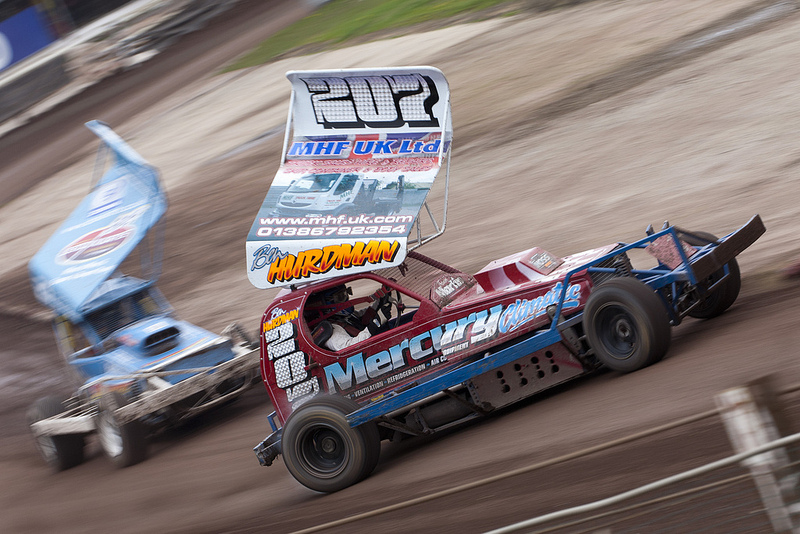
Setting up your camera correctly, and knowing where all of the setting are is essential when action is coming thick and fast, like with these F1 stock cars in Sheffield. (1/80 f/7.1 210mm)
This mode will allow you to control the shutter speed of the camera, and will automatically change the aperture depending on the reading from the light metre.
I would suggest setting the shutter speed to around 1/80s as a starting point. This should allow for a blurred background, while keeping the subject in focus as it moves by.
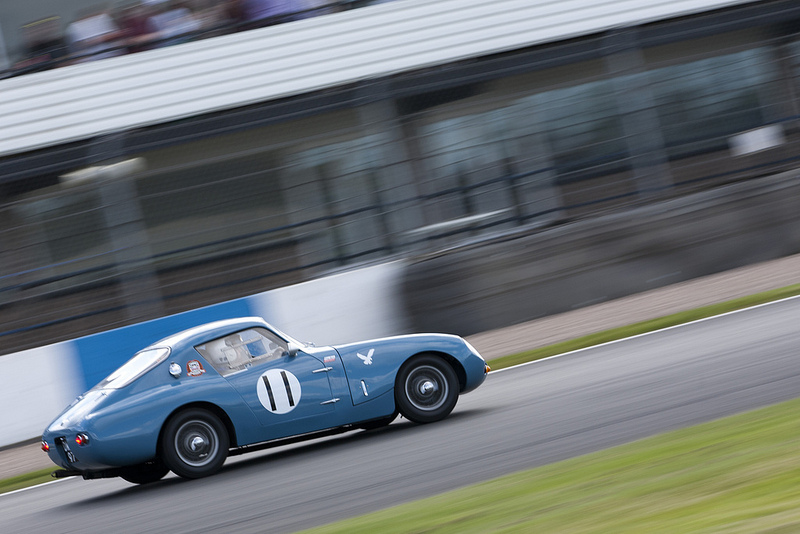
Using a shutter speed of 1/80 is a good starting point for panning shots. This will allow you to see if you need to increase or decrease the shutter speed. (1/80, f/9.0 200mm)
Also make sure that you have an appropriate ISO – if it’s bright and sunny, 100 should be enough. If you’re photographing in rain or on a cloudy day, 160 ISO or 200 ISO should be sufficient.
You should also set your camera to continuous shooting, so that you can shoot several frames as the subject passes.
A choice of focusing
There are two ways of focusing when panning. Firstly, auto focus will work, but you may need to change it to ‘AI Servo’ (on a Canon camera) which will constantly refocus as the subject move. This can be a bit his and miss, as the system can jump back and forth as the subject passes.
Secondly, you can pre-focus by disabling AF, and focusing the camera on where the subject will be when you want to photograph it. The disadvantage of this is that you may not know where the subject will be (if photographing banger racing or stock cars), and if there is an incident such as a spin, you will have to quickly refocus. You should try both method and see which is suitable.
How to move when panning
Now that your camera is set up, and you’re focused on the subject, it’s time to pan. Try and rotate the upper half of your body, framing the subject constantly. Continue to pan with the car as it passes, otherwise you can inadvertantly start to lower the camera before the shutter has completely shut. I usually shoot 3 or 4 shots as a subject passes.
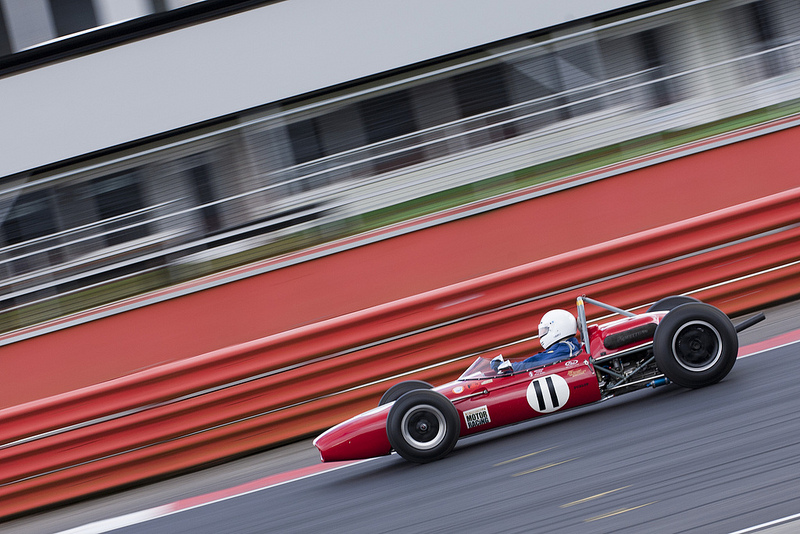
Moving smoothly is essential when trying to capture a sharp subject. (1/125 f/7.1 222mm)
Try and resist shooting as fast as your camera will allow, as the movement of the mirror will temporarily blind you, and you will just take a lot of badly framed shots which you’ll have to sort out later.
Now that you’ve got some shots, you can evaluate a number of things:
- The framing of the photograph – does it follow any of the basic composition rules?
- Is the subject sharp? – If not, then you will need to make your shutter speed faster
- Is the photograph well exposed? It may be too bright for the ISO you are using, or the metering mode may need changing
As you get more confidence in panning with subject, you may want to try reducing the shutter speed to increase the blurring effect of the background. This can however result with subjects not being in focus correctly, or overexposure as the limit of the lens’s aperture is reached.
The basic rule is that the slower the shutter speed, the less likely you are to capture a sharp shot, but the greater the sense of movement will be.
What to consider when setting up
There are several key things to remember when setting up your camera for panning shots:
- The distance to the subject – the further away, the lower the shutter speed, or if you are really close, the shutter speed will need to be faster
- Speed of the subject – the faster it is, the faster the shutter speed you will need
- Focal length – wide shots can use slower speeds, long shots need faster speeds to reduce camera shake
- Direction of the light – if the light is in front of you, you may need to compensate to get the correct exposure
Once you have some experience, try experimenting by changing these settings to change the effect you get. Too fast a shutter speed, and you will reduce the sense of movement. Too slow, and you risk having a blurred subject
Framing when panning
Using wide focal lengths
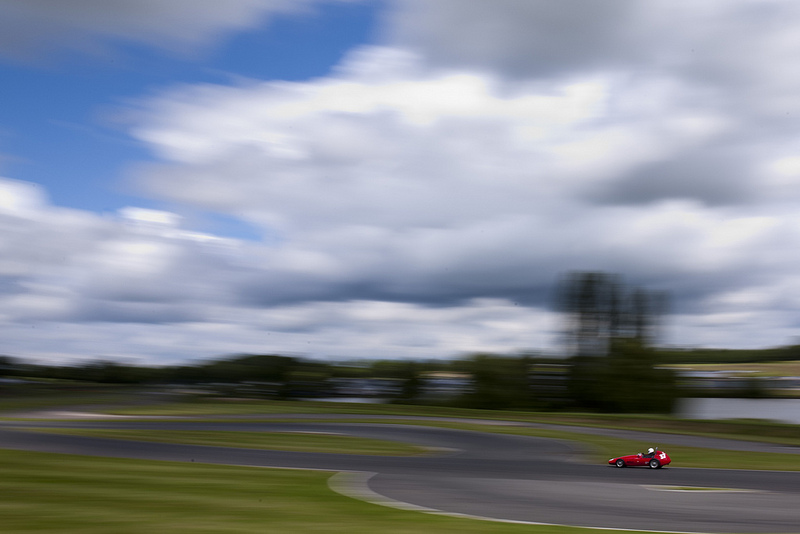
Here I’ve used a wide angle from a long distance. This creates a sense of scale, and with a beautiful sky adds additional interest. (1/15 f/22 28mm)
It’s easy to get into the mindset that a photograph of a racing car, or any other moving subject, should fill the frame by using a long lens and zooming right it. This however is not always the case. Using wide lenses from far away, and panning with subjects can create shots with an amazing sense of scale and place.
Portrait orientation shots
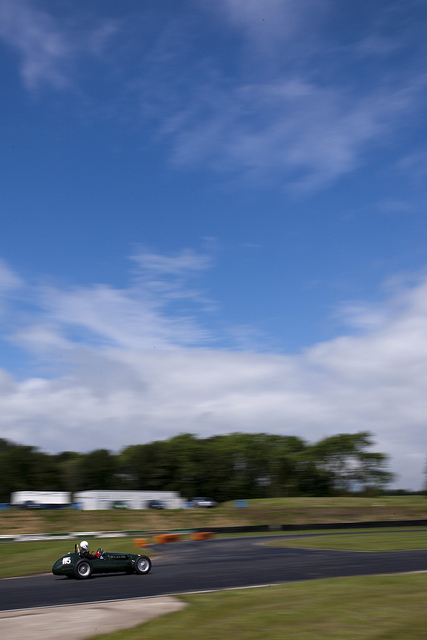
Portrait orientated shots canuse a simple rule of thirds configuration, with the car occupying the bottom 1/3, and the background and sky the top 2/3s. (1/80 f/22 28mm)
Your camera can also be used in portrait orientation to capture subjects. I often do a 2/3 to 1/3 split if there is a dramatic sky or background, with the bottom third banning with a car, and the top two thirds filled with brilliant blue and fluffy white clouds.
Angling the camera body
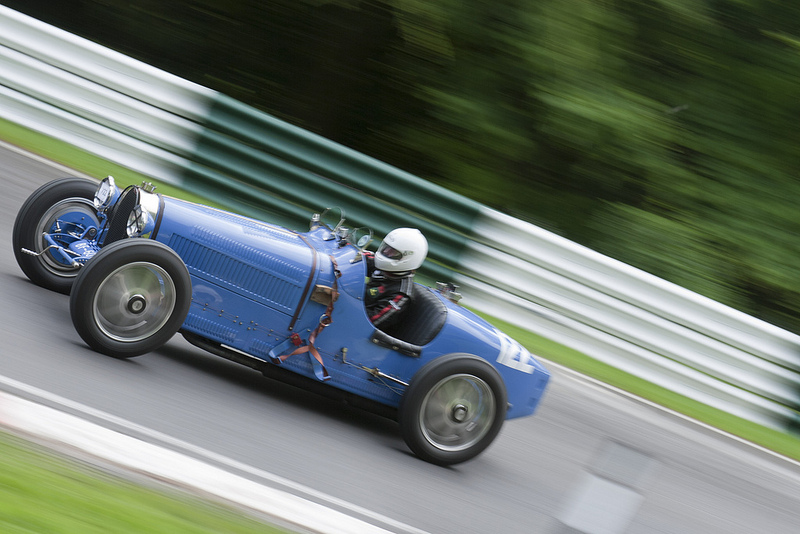
Angling the body of the camera can create a more exciting and dramatic shot when combined with the panning technique. (1/50 f/8 75mm)
Leaning the camera can add dramatic leading lines to a photograph, creating new shapes and angles to what would otherwise be a rather timid photograph.
Using objects in the background
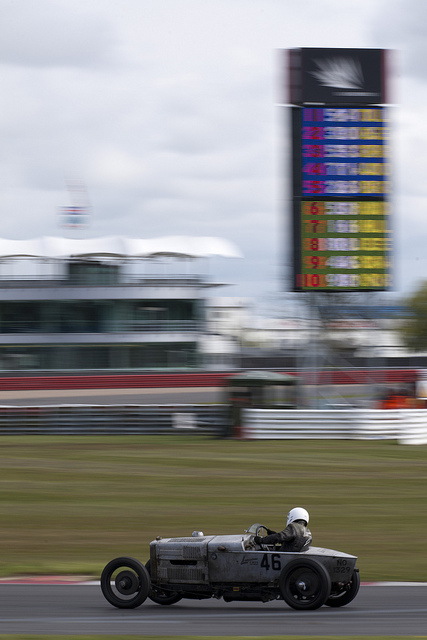
Here I’ve used the timing tower to create an element of interest in the background. The blurring of the Silverstone logo provides a sense of narrative to the photograph. (1/80 f/14 150mm)
Interesting building or trees can be used to add extra interest to photographs, and also provide a sense of scale and place, much like using a wide shot. This often works best with buildings which are associated with the location or subject.
Shooting with and through the foreground
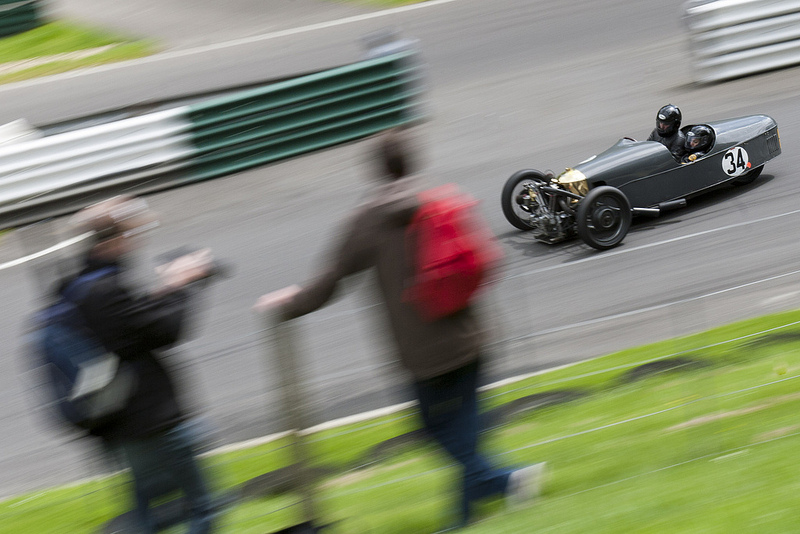
Here I’ve used the spectators watching to create a foreground to shoot through. This gives a sense of place, additional depth and context. (1/50 f/14 60mm)
These type of shots use the forground as an extra area of interest. You could use trees, fences and spectators to give a sense of place to the photograph. These can be tough shots to get, so you may need to take a lot of photographs before getting one that is just right.
Shots from a distance
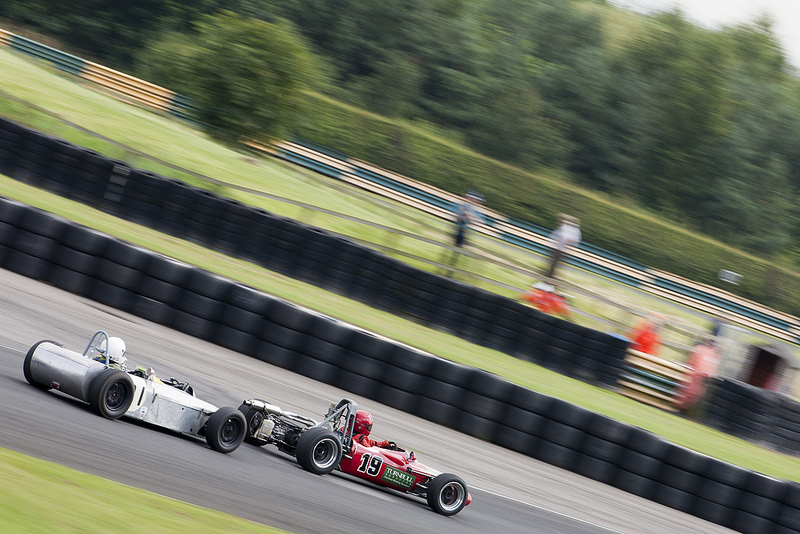
Shots from afar can use the blurring technique to show both background and action in one shot. (1/80 f/11 265mm)
When photographing from a distance, the amount you will have to pan will be reduced. This means that you can use a slower shutter speed, as there is more chance of you being able to pan smoothly. These can create great landscape style photographs, with movement clearly visible in the background.
Superblur shots
One of the most experimental ways to use panning is with what I call the ‘superblur’ style of shot. This uses very low shutter speeds to create very blurry shots, which capture the basic shapes of the car along with trails of colour as the car moves out of the shot.
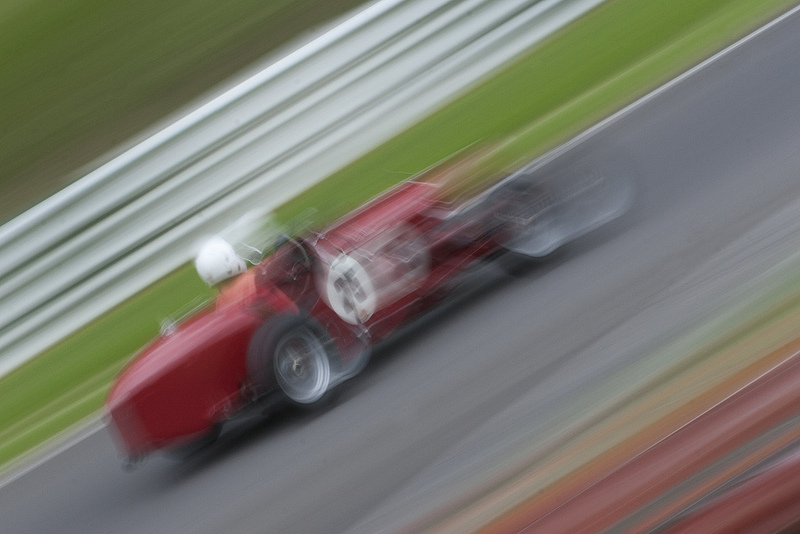
A super slow shutterspeed can result in artistic, ghostly photographs. These shots are very difficult, and you will have many unsuccessful attempts. (1/5 f.25 135mm)
Typically these shots are taken at around 1/4 of a second, or even slower. For these, I find that turning off Image Stabilisation will produce better results, as the lens will not try and compensate for the swing of the camera.
Panning shots on film cameras
I have in the past used film cameras, including medium format TLRs to capture shots with panning. This can be difficult, due to the reversed viewfinder (on TLRs) or the limited amount of shots available.
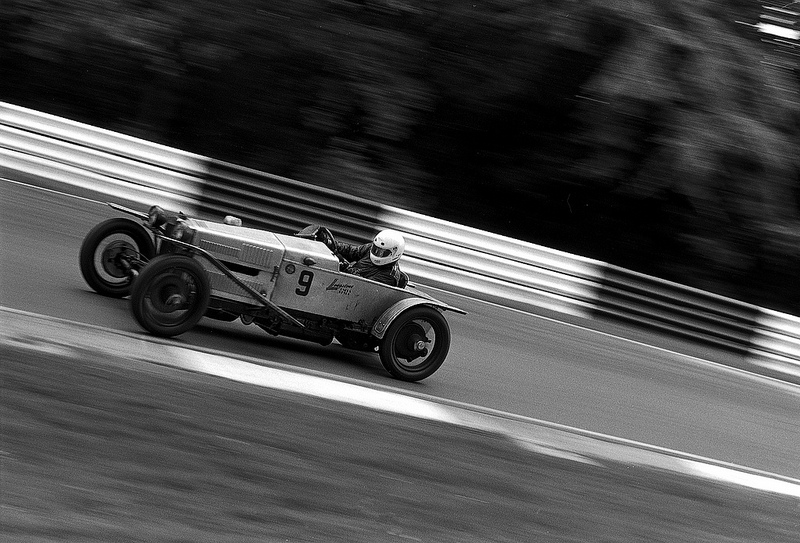
Panning shots on film may need a more pragmatic approach, with a higher shutter speed being used to avoid wastage of a very limited number or frames. (Canon 300v Ilford FP4 Ilfosol 3)
I often increase the shutter speed to increase the chance of getting a sharp shot, even if this can limit the creative effect.
Things to remember
The key to panning shots is, above all, practice. Over time, you will be able to get a better grasp of what shutter speed you need to use, for what speed car, from what distance. Digital photography is an excellent platform to practice on, due to the ability to instantly look at photographs and evaluate any adjustments that are needed. Use this to your advantage when you’re out shooting.
Further reading
You can see many panning shots on my Flickr page, and many of the shots from this article are included in the Mallory park Flickr set, or the Cadwell Park Flickr set. These are two great circuits to visit if you want to try out panning yourself, as they have spectator areas relatively close to the action. I would also recommend the Motorsport Photography book by Tony Pleavin as a good place to look if you want to learn more about the basics of motorsport photography.
If you have any questions, please contact me via twitter, use the comment form below, or by sending me an email.
Posted in: 35mm, Digital, Motorsport, Panning, Techniques, Workflow












